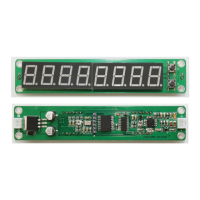PLJ-8LED Frequency Counter User Operating Manual 10
FAQ
1. Will the frequency counter generate any interference when installed in a transceiver?
Zero interference is impossible because the microcontroller, crystal and LED driver all produce some
radiated RF noise, but the level is quite low. Some measures have been taken in the design of the
module to keep certain components away from the transceiver. If interference is encountered, try
changing the position of the module or install a shield.
2. What is the reason for frequency display instability?
First, make sure the quality (strength, stability, etc.) of the input signal meets the minimum
requirements of the module (see Technical Data section). The input cable connecting to the signal
should use shielded wire, and the power supply should also be suitable. Check it has no noise or
ripple.
3. Why is the display showing values when there is no input signal?
Check if the ripple on the power supply being used with the module is too large, then check whether
if something near the module is generating a strong signal. The module can reject invalid signals by
using signal filtering. On the low range (CH L), filtering removes invalid signals below 50kHz, and
below 20MHz on the high range (CH H). This will then result in the normal display showing zero with
no input signal.
4. Since the display is limited to eight digits, how can it display the “hundreds of megahertz” and
gigahertz digits with 0.1s and 1s gate times?
By reducing the gate time or using the LSD function, it is possible to obtain a suitable frequency
display.
For example, when measuring 450.000 000 MHz signal:
When the LSD is OFF (See Menu setup section above)
1S gate display: 50.000.000
0.1S gate display: 450.000.00
When the LSD is ON
1S gate display: 450.000.00
0.1S gate display: 450.000.0
When measuring a 2400.000 000 MHz signal:
When the LSD is OFF
1S gate display: 00.000.000
0.1S gate display: 400.000.00
When the LSD is ON
1S gate display: 400.000.00
0.1S gate display: 2400.000.0

